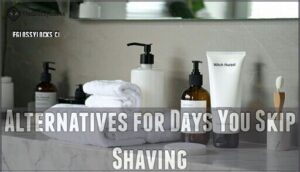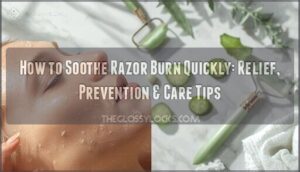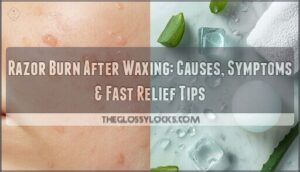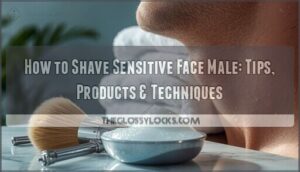This site is supported by our readers. We may earn a commission, at no cost to you, if you purchase through links.
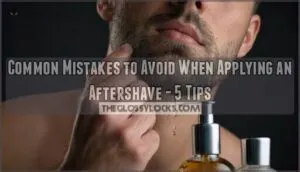
These blunders can leave you looking like you bathed in cologne and feeling like your face is on fire.
Start with just a few drops, pat gently instead of rubbing, and wait until any nicks heal before applying.
Also, don’t ignore your skin type – sensitive skin needs alcohol-free formulas, while oily skin handles stronger solutions better.
Your aftershave routine deserves more finesse than splashing and dashing, using alcohol-free formulas can be beneficial.
Table Of Contents
- Key Takeaways
- Aftershave Application Mistakes
- Top 5 Aftershave Products
- Common Aftershave Errors
- Aftershave Care and Maintenance
- Frequently Asked Questions (FAQs)
- What should you avoid in aftershave?
- Do I apply aftershave to wet or dry skin?
- What do you put on immediately after shaving?
- Should I switch to aftershave?
- Should you apply aftershave after shaving?
- Do aftershaves dry out your skin?
- How to use aftershave splash?
- How are you supposed to apply aftershave?
- What are the disadvantages of aftershave?
- What to do if you put on too much aftershave?
- Conclusion
Key Takeaways
- Don’t splash aftershave on cuts or nicks – You’ll turn a simple shave into a stinging nightmare and risk infection, so wait until wounds heal completely before applying any product.
- Use only a small amount and pat gently – You need just a dime-sized amount for balms or a quarter-sized amount for splashes, and patting prevents irritation while rubbing causes redness and inflammation.
- Match your aftershave to your skin type – You’ll avoid irritation by choosing alcohol-free formulas for sensitive skin, lightweight options for oily skin, and moisturizing balms for dry skin.
- Apply to slightly damp skin, not bone dry – You’ll reduce that alcohol sting and get better absorption when your skin has a bit of moisture left from rinsing.
Aftershave Application Mistakes
Proper aftershave application seems straightforward, but many guys unknowingly sabotage their post-shave routine with these common blunders.
You’re probably making at least one of these mistakes without realizing it, turning what should soothe your skin into a stinging, irritating experience, which is why understanding these common blunders is crucial.
Applying to Cuts or Open Wounds
Why put salt on an open wound? Applying aftershave to cuts or open wounds creates intense stinging sensations and increases infection risks.
Don’t turn your fresh shave into a painful mistake—cuts need healing, not stinging alcohol torture.
The alcohol content can delay healing and potentially worsen scarring potential. Your wound sensitivity is already heightened, so avoid this aftershave mistake entirely.
Instead, try healing alternatives like witch hazel, alum blocks, or aloe vera for safer aftershave application until wounds close completely. Aftershaves with soothing agents can help reduce redness and irritation.
Using Too Much Aftershave
Less is definitely more in the application of aftershave.
You don’t need to splash it on like cologne.
Using too much aftershave leads to scent overpowering everyone around you, skin irritation from concentrated ingredients, and product waste that’ll empty your bottle fast.
A dime-sized amount for balms or quarter-sized for splashes is plenty.
Remember, proper application technique means moderation – your face will thank you later.
Many prefer using an aftershave balm product to soothe the skin.
Rubbing Instead of Patting
Stop aggressive aftershave application that’s irritating your skin. Vigorous rubbing creates redness and inflammation, while gentle patting preserves your skin’s barrier and maximizes absorption benefits.
Here’s why patting wins over rubbing:
- Skin Irritation Prevention – Patting reduces friction that causes immediate redness
- Better Absorption Benefits – Gentle application allows aftershave to penetrate properly
- Technique Comparison – Rubbing damages delicate post-shave skin versus nurturing pat motions
Think of your freshly shaved face like sunburned skin—it needs TLC, not a vigorous massage.
Ignoring Skin Type and Sensitivity
One-size-fits-all aftershave is like wearing someone else’s glasses—it rarely works perfectly.
Using generic aftershave on every skin type is like wearing the same shoe size for everyone.
Your skin type matters tremendously when choosing aftershave products. Sensitive skin needs alcohol-free formulas with soothing ingredients, while oily skin benefits from lightweight, non-comedogenic options.
Dry skin craves moisturizing balms over harsh splashes.
Always patch test new products and watch for sensitivity indicators like redness or irritation.
Many find relief using specialized shaving products.
Top 5 Aftershave Products
Choosing the right aftershave can be tricky when you’re not sure which products actually deliver on their promises.
These five standout options have earned their reputation through consistent performance and positive user feedback, making them reliable choices for different skin types and budgets.
1. NIVEA Men Sensitive Post Shave Balm
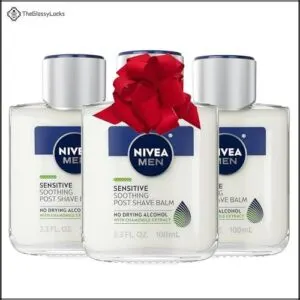
NIVEA Men Sensitive Post Shave Balm earns its top spot for good reason – it’s like a gentle hug for your freshly shaved face.
This alcohol-free formula combines chamomile extract, Vitamin E, and Pro-Vitamin B5 to tackle the five major shave irritation culprits: burning, micro cuts, dryness, tightness, and that annoying stubble itch.
You’ll love how quickly it absorbs without leaving your skin feeling like a greasy pizza slice. It’s also great for soothing razor burn.
It’s dermatologically tested and perfect for daily use, even on sensitive skin.
Best For: Men with sensitive skin who need gentle, effective post-shave relief from irritation, burning, and dryness.
- Alcohol-free formula with chamomile extract reduces post-shave redness by up to 60% while being gentle on sensitive skin
- Fast-absorbing, non-greasy texture provides immediate comfort and long-lasting hydration without clogging pores
- Three-pack offers excellent value with 9.9 total fluid ounces and consistently high user satisfaction ratings
- Packaging issues reported with bottles potentially spilling during travel or shipping
- No travel-size option available for convenient portability
- Limited to post-shave use rather than being a multi-purpose skincare product
2. Bee Bald HEAL Aftershave Balm
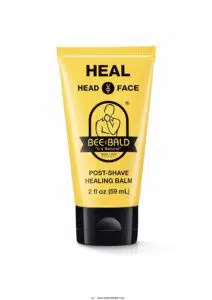
Designed specifically for head-shavers, Bee Bald HEAL offers a game-changing formula that works wonders on any shaved area.
You’ll love its natural honey and bee pollen ingredients that provide instant relief from razor burn and bumps.
The lightweight, non-greasy texture absorbs quickly, leaving your skin smooth without residue, and a dime-sized amount goes a long way, making this compact tube travel-friendly and economical.
Its subtle eucalus-citrus scent won’t compete with your cologne, ensuring you can use Bee Bald HEAL with your favorite cologne.
Best For: Head-shavers and anyone with sensitive skin prone to razor burn, bumps, and post-shave irritation who wants instant relief with natural ingredients.
- Provides immediate soothing relief from razor burn, redness, and bumps with natural honey and bee pollen ingredients
- Lightweight, non-greasy formula absorbs quickly without leaving residue, with a subtle eucalyptus-citrus scent that won’t interfere with cologne
- Highly concentrated and economical – a dime-sized amount covers large areas, making the compact 2-ounce tube travel-friendly and long-lasting
- Some users report poor absorption with glue-like consistency that can cause peeling or clumping on the skin
- Not suitable for individuals with bee-related allergies due to honey, bee pollen, and propolis ingredients
- May provide insufficient moisturizing for very dry skin types, working best on normal to combination skin
3. Cremo Cooling Post Shave Balm
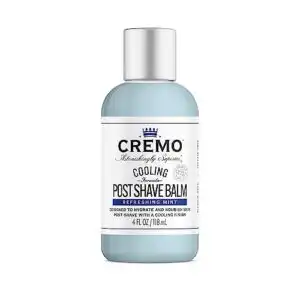
In terms of cooling relief, Cremo’s aftershave balm delivers like a champ.
You’ll get that invigorating menthol kick without breaking the bank—around $10 beats pricey alternatives any day.
The tea tree oil and shea butter combo soothes razor burn while keeping your skin hydrated.
Just remember, a pea-sized amount goes far, so don’t overdo it unless you want to feel like you’ve rubbed toothpaste on your face.
Perfect for hot days when regular balms feel too heavy.
Best For: Men who want cooling relief from razor burn and shaving irritation without spending premium prices on aftershave products.
- Delivers effective cooling sensation with menthol and tea tree oil that soothes razor burn and reduces post-shave irritation
- Excellent value at around $10 compared to high-end alternatives, with a little product going a long way
- Non-greasy, quick-absorbing formula that deeply moisturizes without leaving oily residue
- Strong menthol kick may be too intense for sensitive skin or areas with micro-cuts from shaving
- Medicinal mint fragrance can be off-putting initially, though it fades relatively quickly
- Packaging design makes dispensing difficult, with users preferring squeezable tube format over current bottle
4. Gillette After Shave Gel Sensitive
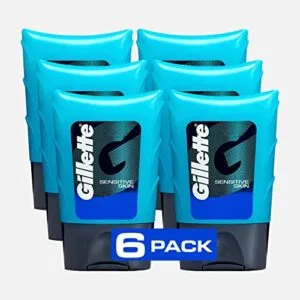
Sensitivity meets sophistication with Gillette’s gentle formula that won’t leave your face feeling like a battlefield.
You’ll appreciate its alcohol-free composition, which prevents the dreaded post-shave sting while delivering cooling relief through menthol and aloe vera.
The non-greasy gel absorbs quickly, making it perfect for daily use without clogging pores or creating shine, and at 75 milliliters, this bottle lasts over a month with regular application, offering excellent value for sensitive skin types.
Best For: Men with sensitive skin who want effective post-shave cooling without alcohol burn or greasy residue.
- Alcohol-free formula prevents stinging while menthol and aloe vera provide soothing relief
- Non-greasy gel texture absorbs quickly without clogging pores or creating shine
- Long-lasting 75ml bottle offers over a month of daily use at excellent value
- Some users find the masculine scent too strong or overpowering
- Requires gentle patting application rather than rubbing to avoid irritation
- Not suitable for application on active cuts or broken skin
5. Proraso Refreshing After Shave Lotion
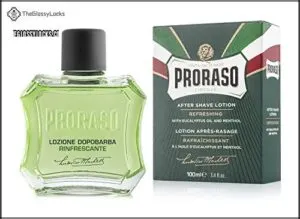
Proraso’s rejuvenating lotion delivers that classic barbershop experience you’ve been missing.
With 97% natural ingredients including witch hazel and eucalyptus, it soothes irritation while providing antibacterial protection.
The menthol creates an invigorating cooling sensation that transforms your daily routine.
Just remember to pat gently—rubbing can aggravate sensitive skin.
While the initial alcohol sting might make you wince, it quickly fades into revitalizing relief that leaves your skin feeling clean and revitalized.
Best For: Wet shavers seeking a traditional barbershop experience with natural ingredients who can tolerate menthol’s cooling intensity and initial alcohol sting.
- 97% natural ingredients including witch hazel and eucalyptus provide effective antibacterial protection and soothing relief
- Delivers authentic cooling barbershop sensation that transforms daily shaving into an invigorating ritual
- Excellent value with long-lasting formula suitable for all skin types including sensitive skin
- Initial alcohol burn can be intense on freshly shaved or nicked skin before cooling relief sets in
- Strong menthol and eucalyptus scent may cause eye irritation or bitter taste if applied too close to facial features
- Requires gentle patting application technique as rubbing can aggravate post-shave sensitivity
Common Aftershave Errors
You’re not alone if you’ve made these aftershave blunders – even experienced shavers slip up sometimes.
These common errors can turn your post-shave routine from soothing to stinging, but they’re easy to fix once you know what to watch for, and making these changes can lead to a more soothing experience.
Applying to Dry Skin
Most folks make the mistake of slapping aftershave onto completely dry skin, which cranks up the alcohol content’s sting factor.
Your skin’s hydration importance can’t be overstated – damp skin reduces dryness severity and helps with proper application technique.
Smart application timing means patting aftershave onto slightly moist skin for better absorption and balm benefits, keeping your skin happy instead of irritated, by utilizing the correct method for a more pleasant experience with proper application technique.
Overlooking Expiration Dates
You’ll want to check those expiration dates before slapping on your aftershave.
Expired products lose their effectiveness and can harbor bacteria that cause irritation or breakouts.
Look for scent changes, color shifts, or texture problems—clear expiration signs that it’s time to toss the bottle.
Most aftershaves last two to five years, but poor storage conditions drastically reduce shelf life and accelerate product degradation.
To guarantee safety and efficacy, understand the importance of beauty product expiration.
Not Adjusting Amount Based on Skin Needs
Based on your skin needs, you’ll want to adjust your aftershave application throughout the year.
Dry skin craves more moisture, while oily skin needs less product to avoid clogged pores.
Consider these factors:
- Seasonal adjustments – winter requires heavier application
- Skin hydration levels – dehydrated skin absorbs more product
- Individual sensitivity – some folks need gentler, smaller amounts
Aftershave Care and Maintenance
You’ll get the best results from your aftershave when you store it properly and know when it’s time for a replacement.
Taking care of your aftershave isn’t rocket science, but a few simple habits can save you from skin irritation and wasted money.
Proper Storage and Handling
Store your aftershave in a cool, dark spot away from sunlight exposure and temperature fluctuations.
Heat and light cause product degradation, shortening shelf life substantially.
Keep containers sealed tight to maintain integrity—nobody wants their aftershave turning into expensive water! Check for oxidation to guarantee its quality.
Check expiration dates regularly and practice safe disposal when products go bad. Your bathroom cabinet beats the windowsill every time.
Identifying Signs of Expired Aftershave
Your aftershave’s gone bad when you spot color changes from clear to yellow or brown.
Scent alteration hits next—that fresh fragrance turns sour or disappears completely.
Consistency shifts mean your smooth balm becomes chunky or watery.
Performance decrease follows, with less soothing power than before.
When separation occurs, ingredients split like oil and water.
Check expiration dates regularly—expired aftershave won’t protect your skin properly.
Benefits of Regular Aftershave Use
Beyond checking expiration dates, you’ll discover that regular aftershave application transforms your post-shave routine.
Using aftershave consistently soothes irritation and reduces razorburn while preventing ingrowns through its antibacterial properties. Your shaving frequency doesn’t matter—aftershave mistakes happen when you skip this essential skin care step.
Aftershave also provides vital skin protection from pollutants.
- Wave goodbye to razor burn – Your skin gets the TLC it deserves after each shave
- Stop ingrown hairs in their tracks – No more painful bumps ruining your smooth look
- Feel confident in your skin – Daily aftershave application keeps irritation at bay
- Build a postshave routine that works – Consistent care means healthier, happier skin
Alternatives for Days You Skip Shaving
When you skip shaving, your skin still craves care.
Light moisturizers with hyaluronic acid boost skin hydration by 30%, preventing dryness and flakiness. Witch hazel acts as a natural soother, tightening pores without alcohol’s sting.
Try gentle exfoliation weekly or dab aloe vera gel for cooling relief. These alternatives keep your skin happy between shaves.
A light skin moisturizer can help maintain hydration.
Frequently Asked Questions (FAQs)
What should you avoid in aftershave?
Here’s the thing about aftershave ingredients—you’ll want to steer clear of alcohol if you’ve got sensitive skin, since it stings like crazy.
Avoid harsh fragrances and chemicals that’ll leave your face looking like an angry tomato instead of smooth and refreshed.
Do I apply aftershave to wet or dry skin?
You’ll want to apply aftershave to slightly damp skin, not bone-dry. This helps reduce that alcohol sting and lets the product absorb better, giving you smoother results without irritation.
What do you put on immediately after shaving?
Unfortunately, you can’t please everyone—some swear by cold water, others demand warm towels.
Right after shaving, you’ll apply aftershave to damp (not soaking) skin, patting gently rather than rubbing to avoid irritation.
Should I switch to aftershave?
You should consider switching to aftershave if you’re experiencing irritation, razor burn, or ingrown hairs after shaving.
It’ll help soothe your skin and prevent those annoying bumps that can ruin your day, by using aftershave.
Should you apply aftershave after shaving?
Picture John rushing out the door after a quick shave, skipping aftershave to save time.
Yes, you should apply aftershave after shaving—it soothes irritation, prevents razor burn, and keeps your skin healthy and comfortable.
Do aftershaves dry out your skin?
Yes, alcohol-based aftershaves can dry out your skin by stripping away natural oils. However, alcohol-free balms and lotions actually moisturize while soothing post-shave irritation, keeping your skin hydrated.
How to use aftershave splash?
Some worry aftershave splash stings too much, but it’s manageable with proper technique.
Pour a teaspoon into your palm, pat gently onto damp shaved skin, and let it absorb naturally without rubbing.
How are you supposed to apply aftershave?
Apply aftershave to clean, damp skin using gentle patting motions instead of rubbing.
Use a small amount—about dime-sized for balms or teaspoon for splashes.
Cover shaved areas completely, including your neck.
What are the disadvantages of aftershave?
Aftershave can absolutely wreck your skin if you’re not careful.
You’ll face stinging from alcohol content, potential allergic reactions from fragrances, and possible irritation that leads to redness or dryness, especially on sensitive skin with potential allergic reactions.
What to do if you put on too much aftershave?
If you’ve overdone it, blot excess aftershave with a clean towel immediately.
Rinse your face with cool water to dilute the product and reduce irritation.
Next time, remember less is more!
Conclusion
Remarkably, many men repeat the same common mistakes to avoid when applying an aftershave without realizing they’re sabotaging their grooming routine.
You’ve learned that gentle patting beats aggressive rubbing, less product works better than more, and matching your aftershave to your skin type prevents irritation.
Remember to wait until cuts heal and store your product properly.
With these simple adjustments, you’ll transform your post-shave experience from painful to rejuvenating every single time.







